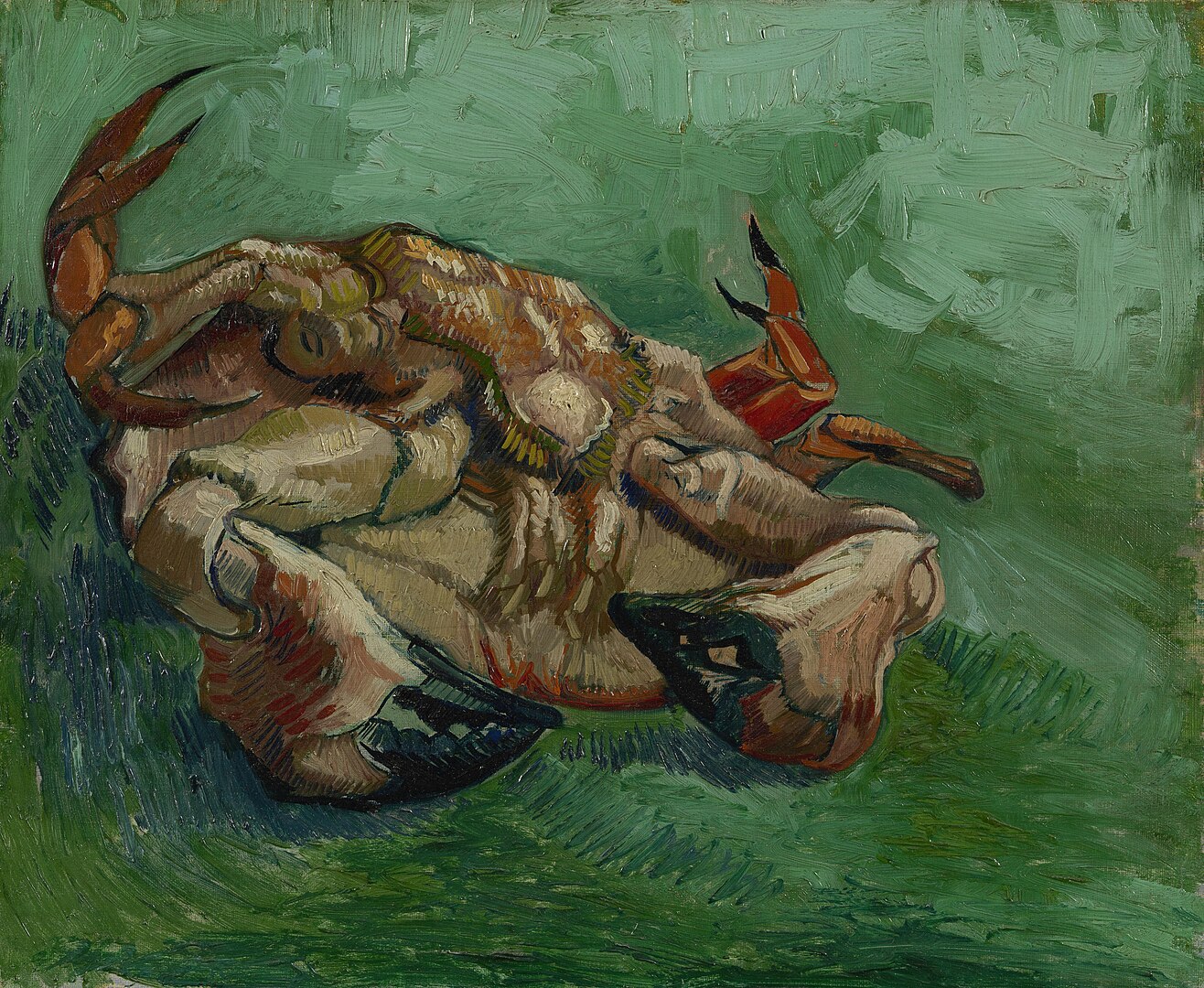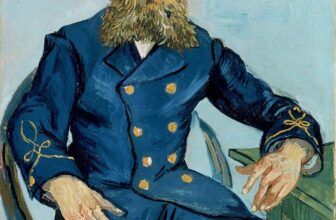
Meaning of Crab on Its Back Painting by Vincent van Gogh
In the untidy gallery of Vincent van Gogh’s prolific body of work, some paintings are loud with color and emotion, while others whisper quieter tales, subtle expressions of introspection, struggle, and fleeting clarity. One such painting is “Crab on Its Back”, a deceptively simple image that, upon closer examination, reveals itself to be rich in psychological depth, personal symbolism, and expressive power.
Although it is not as widely known as Starry Night or Sunflowers, Crab on Its Back has intrigued art historians and Van Gogh enthusiasts alike for decades. It is a small oil painting of a green crab, lying helplessly on its back on a reddish-brown background, legs flailing upwards, unable to right itself. But this singular crustacean encapsulates a world of meaning, of struggle, futility, and perhaps even hope.
The Painting at a Glance
Title: Crab on Its Back
Artist: Vincent van Gogh
Date: December 1887 – January 1888
Medium: Oil on canvas
Dimensions: 38.0 x 46.5 cm
Current Location: Van Gogh Museum, Amsterdam
What is Crab on Its Back Painting All About?
At first sight, the painting might seem merely an academic study, an exercise in form, color, or texture. However, Crab on Its Back carries more than aesthetic experimentation. Painted in Paris during a tumultuous time in Van Gogh’s life, the crab is not just a crustacean; it is an emotional stand-in, a self-portrait of sorts, embodying vulnerability, disorientation, and perhaps resilience.
The painting is startling in its stillness. The crab, flipped over, is in a state of helplessness. Unlike the swirling skies or dynamic fields Van Gogh often painted, here the subject is immobilized. And yet, within this stagnation lies emotional intensity.
The Context Behind the Crab: Van Gogh in Paris
To understand Crab on Its Back, one must consider Van Gogh’s life in Paris. He arrived there in early 1886, joining his brother Theo in Montmartre. During his two years in the French capital, Van Gogh’s artistic direction underwent dramatic transformation. He moved away from the dark, earthy tones of his earlier Dutch paintings and embraced the vibrant colors and expressive brushwork inspired by Impressionists and Japanese woodblock prints.
But this was also a time of intense psychological strain. Van Gogh suffered from periods of depression, loneliness, and existential anxiety. He was in search of artistic identity, personal belonging, and peace of mind. The painting of the crab may reflect a particularly introspective moment during this Parisian period.
How Was Crab on Its Back Painted?
Technically, the painting is masterful in its simplicity. It’s done in oil on canvas, likely painted in a single session, what artists call alla prima, where wet paint is applied on wet paint. The brushstrokes are visible and vigorous, characteristic of Van Gogh’s expressive style.
The crab is rendered with thick, textured strokes of green and yellow, giving it a near-lifelike sheen. It contrasts starkly against the dark red-brown ground, probably a wooden table or cutting board. The background is painted more thinly, letting some of the underlayer show through, creating a rustic, earthy tone.
There is a strong sense of chiaroscuro, the dramatic interplay of light and dark, highlighting the crab’s curved belly and spiny legs. The sense of volume and depth is palpable, despite the lack of elaborate background or setting.
Symbolism and Meaning in “Crab on Its Back”
1. The Crab as Self-Portrait
Many scholars interpret the crab as a symbolic self-portrait. Van Gogh often used objects, nature, and inanimate subjects as metaphors for his internal states. A crab, overturned and flailing, could easily represent a person struggling with mental illness, anxiety, or creative frustration.
In this light, Crab on Its Back becomes autobiographical, Van Gogh caught in the throes of despair, unable to right himself, overwhelmed by internal turmoil. The crab’s position conveys vulnerability. Its usual protective armor becomes useless when inverted. The metaphor is striking.
2. A Nod to Japanese Influence
There is reason to believe Van Gogh was inspired by a Japanese print that depicted a crab. During his time in Paris, he became enamored with Japanese ukiyo-e prints, collecting and displaying them on his walls. In particular, a woodcut by the Japanese artist Hokusai featuring a crab may have sparked this work.
The composition and minimalist background in Crab on Its Back echo the Japanese aesthetic, emphasizing form, negative space, and symbolic resonance over narrative detail. This connection further enhances the painting’s contemplative nature.
3. Thematic Exploration: Struggle and Resilience
The crab’s situation is precarious but not without possibility. Crabs, after all, are known to flip themselves back over. This ambiguity, will the crab succeed or perish?, adds emotional complexity. Is the painting about helplessness or hope?
Van Gogh was no stranger to emotional ambiguity. He often painted scenes that oscillated between joy and melancholy, beauty and decay. Crab on Its Back fits neatly into this paradigm. It invites the viewer to project their interpretation: is the crab symbolic of defeat or survival?
4. Isolation and Stillness
There is no background narrative in this painting, no sea, no kitchen, no setting. The crab exists in a void-like space, isolated, exposed. This stark presentation mirrors Van Gogh’s own feelings of alienation. In many of his letters, he described himself as someone struggling to find connection and understanding.
The isolation of the crab on a featureless surface reinforces this solitude. It’s not part of a natural scene, it is alone, the center of focus, vulnerable in its unnatural position.
What is Happening in Crab on Its Back Painting?
Literally, a crab lies on its back, legs raised, possibly mid-motion. It is caught in an awkward, almost tragic pose. This isn’t a crab in a moment of action, it’s in a moment of crisis.
There’s a stillness that borders on discomfort. The crab is exposed, its soft underbelly visible, unlike the usual armored exterior. The viewer is forced to confront this moment of disempowerment, a state that contrasts with the crab’s usual connotations of toughness and protection.
The painting freezes the moment before resolution. It doesn’t tell us what happens next. This “suspended animation” makes the painting particularly evocative, compelling viewers to contemplate the tension between vulnerability and survival.
What Type of Art is Crab on Its Back Painting?
Crab on Its Back falls under Post-Impressionism, the broad movement that came after, and in reaction to, Impressionism. Van Gogh was a key figure in this movement, which sought to infuse greater emotional depth, symbolism, and structure into the spontaneous brushwork and light play of the Impressionists.
The painting also demonstrates elements of:
Expressionism: It expresses an internal state rather than depicting reality.
Still Life: Though unconventional, it qualifies as a still life, focusing on a single object.
Japanese influence: As noted, the minimalist composition and symbolic treatment echo Japanese art.
Unlike traditional still lifes of fruit or flowers, Van Gogh’s crab is emotionally loaded. The raw colors, bold lines, and lack of background elevate the subject from mere study to existential metaphor.
Where is Crab on Its Back Painting Located Today?
Today, Crab on Its Back is housed in the Van Gogh Museum in Amsterdam, Netherlands. It is part of their permanent collection and is occasionally displayed depending on the curatorial rotation.
The museum, which holds the largest collection of Van Gogh’s works, provides invaluable context for understanding his art, letters, and mental health. Seeing Crab on Its Back in this setting allows viewers to connect it with other pieces from the same period and trace the emotional and stylistic arc of his development.
Comparative Note: A Second Crab Painting?
Interestingly, there is a related painting simply titled “Crab”, where the creature is upright, walking across the same reddish-brown surface. Scholars speculate that Van Gogh may have painted the overturned crab first and then painted the upright one later, as a kind of resolution or optimistic sequel.
If so, the two paintings together tell a fuller story: one of despair followed by recovery. Whether this was intentional or coincidental remains unclear, but the duality is powerful.
A Small Painting with Monumental Emotion
Crab on Its Back might seem like a minor work in Van Gogh’s oeuvre, overshadowed by his more famous masterpieces. But it encapsulates everything that makes Van Gogh unforgettable: emotional honesty, bold experimentation, and the ability to find meaning in the mundane.
This small painting of an upturned crab becomes a mirror, of Van Gogh’s psyche, of human vulnerability, and of the eternal struggle between despair and perseverance. It’s a testament to Van Gogh’s genius that something so ordinary, a crab, can carry such profound weight.
In its stillness, Crab on Its Back speaks. It whispers of battles fought within, of days spent immobilized by sorrow or anxiety. But perhaps, too, it suggests the possibility of motion, of righting oneself, one leg at a time, until balance is restored.
In the language of visual art, every brushstroke is a word, and every painting a paragraph in the diary of the soul. Crab on Its Back may only be a page in Van Gogh’s vast visual journal, but it is one etched in bold, honest strokes.
Whether you see the crab as a symbol of helplessness, a moment of introspection, or a metaphor for the human condition, one thing is certain: Van Gogh, in his inimitable way, turned even a crab into a story of profound emotional resonance.




